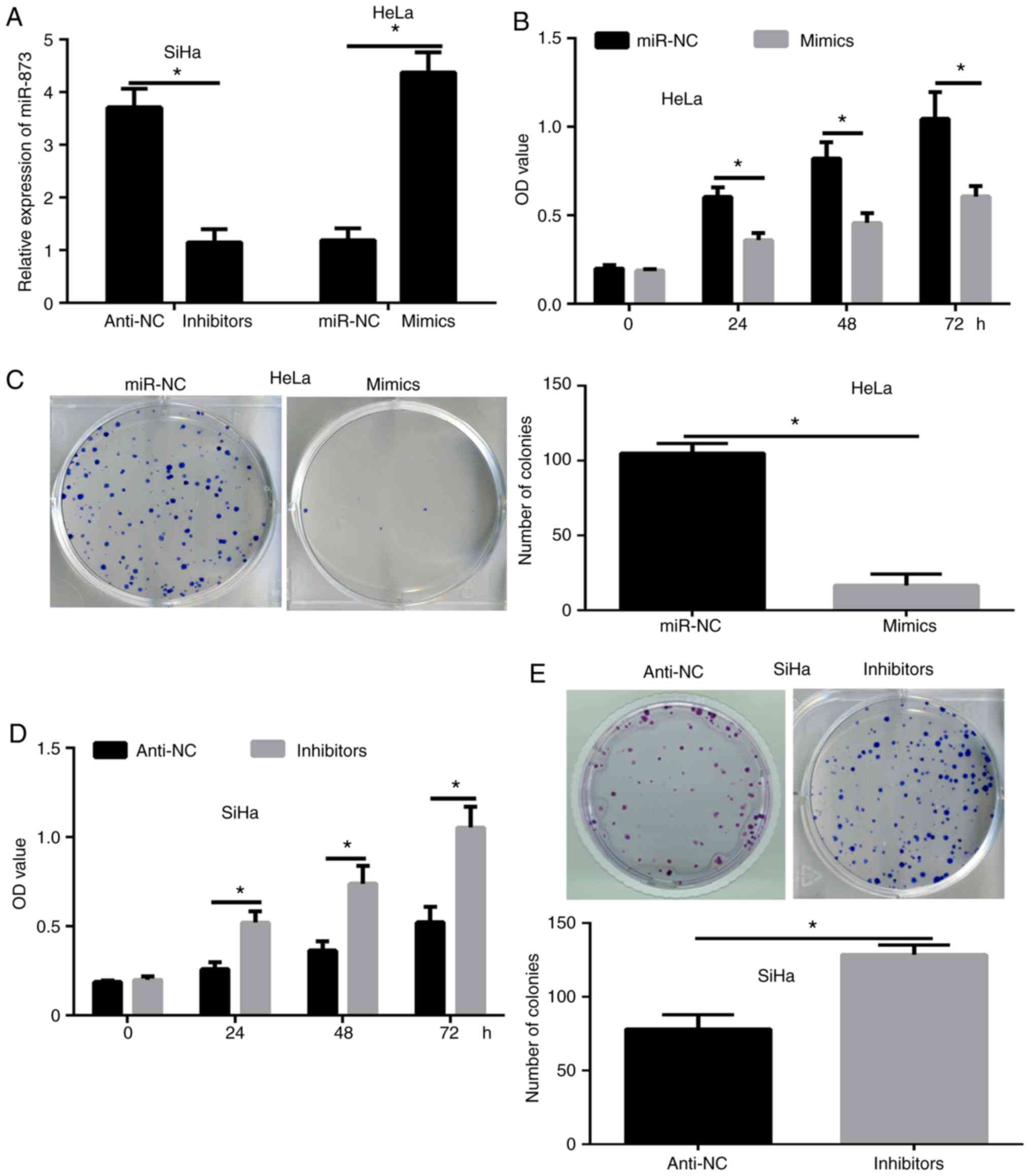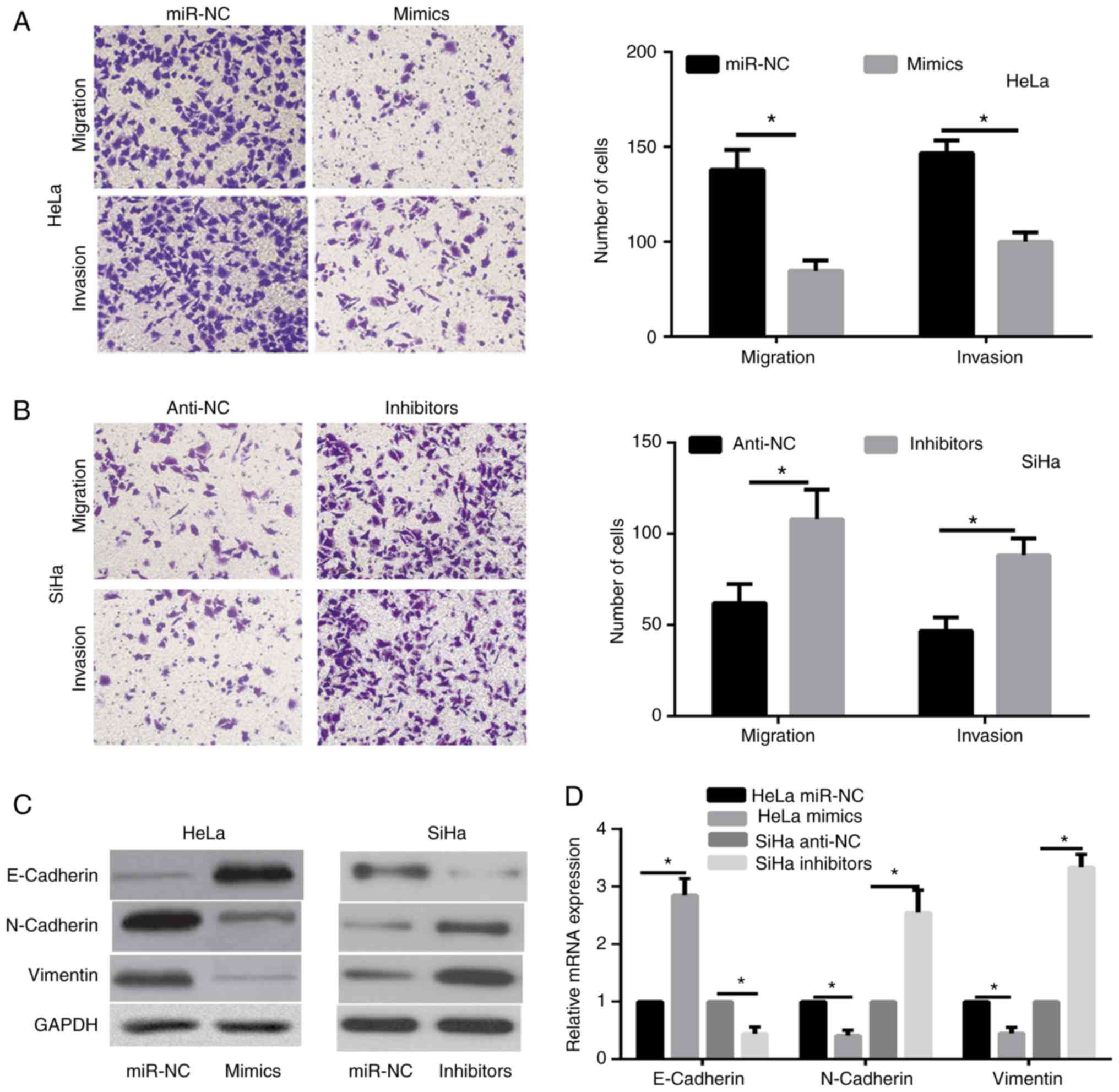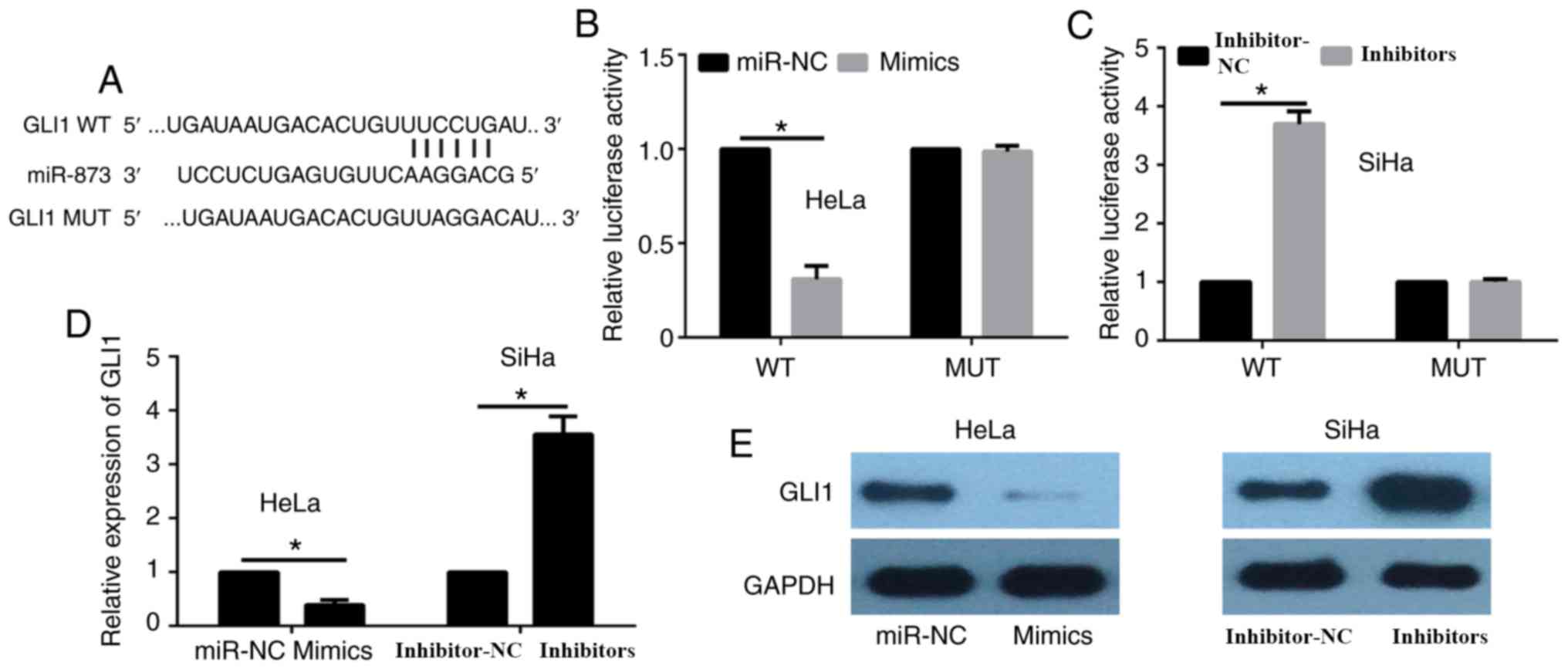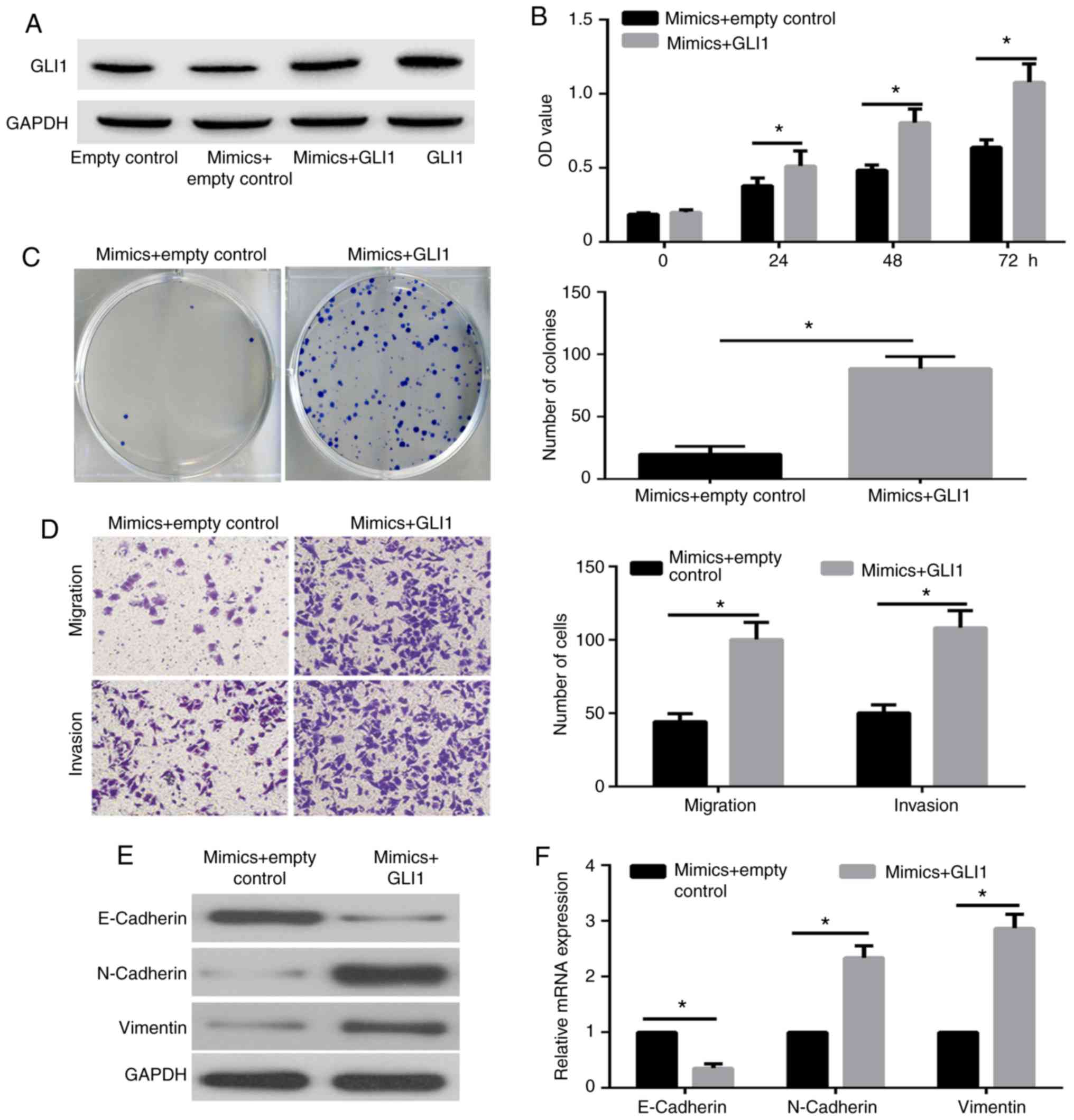MicroRNA‑873 serves a critical role in human cervical cancer proliferation and metastasis via regulating glioma‑associated oncogene homolog 1
Retraction in: /10.3892/etm.2024.12451
- Authors:
- Published online on: December 18, 2019 https://doi.org/10.3892/etm.2019.8348
- Pages: 1243-1250
-
Copyright: © Feng et al. This is an open access article distributed under the terms of Creative Commons Attribution License.
Abstract
Introduction
Cervical cancer is one of most common types of malignancies in females worldwide (1). In 2012, a total of 527,600 women developed cervical cancer globally, and 265,700 patients succumbed to the disease (2). At present, the standard treatment strategy for cervical cancer involves surgical resection, followed by chemotherapy and radiotherapy (3); however, the prognosis of cervical cancer remains poor (3). Therefore, improving the understanding on the molecular interactions occurring during the initiation and progression of cervical cancer may be useful in identifying therapeutic targets and providing new prognostic treatments.
MicroRNAs (miRNAs) are a class of small noncoding RNAs that downregulate the translation of target protein-coding mRNAs at the 3′-untranslated region (3′-UTR) (4). Accumulating evidence indicated that miRNAs enhance cancer cell proliferation, apoptosis and metastasis in solid tumors and leukemia (5–8). Previous studies have also revealed that abnormal expression of miR-873 occurs in various types of cancer, such as breast, lung, colorectal and ovarian cancer, and glioma (9–17). Notably, miR-873 is crucial for paclitaxel and cisplatin sensitivity in ovarian cancer and cisplatin sensitivity in glioma (18,19). However, the expression and function of miR-873 in cervical cancer are not fully understood.
In the present study, it was first illustrated that the expression level of miR-873 was significantly decreased in the cervical tumor tissues and cancer cell lines, and that overexpression of this miRNA inhibited the tumor growth and metastasis. Furthermore, the expression levels of a miR-873 downstream target gene, glioma-associated oncogene homolog 1 (GLI1), were analyzed in cervical cancer tissues. Finally, it was demonstrated that GLI1 is a target gene of miR-873 and is involved in the function of miR-873 in cervical cancer.
Materials and methods
Tissue collection
Cervical cancer tissues and paired adjacent noncancerous tissues were collected from 20 patients (mean age, 52.23±15.13 years; age range, 41–69 years; stage I, 4 patients; stage II, 11 patients; stage III, 5 patients) who underwent surgical resection for cervical cancer at the Department of Gynecology and Obstetrics, Weifang Maternity and Child Care Hospital (Weifang, China) between December 2015 and December 2016. Patients were excluded from the study if they had received any prior treatment. The acquisition of the samples was approved by the Institutional Review Board of Weifang Maternity and Child Care Hospital. Informed written consent was obtained from all the patients and/or guardians prior to the use of the resected specimens.
Cell culture
Human cervical cancer cell lines (C33A, HeLa and SiHa) and an immortal normal cervical cell line Ect1/E6E7 were purchased from American Type Culture Collection. The cell lines were authenticated by short-tandem repeat profiling performed by BMR Genomics. All cell lines were cultured in Dulbecco's modified Eagle's medium (DMEM) supplemented with 10% fetal bovine serum (FBS; both from Hyclone; GE Healthcare Life Sciences) in a humidified 5% CO2 atmosphere at 37°C.
Transfection of cells with miR-873 mimics or GLI1 overexpression vector
The miR-873 mimics, miR-negative control (NC), miR-873 inhibitors and inhibitor-NC were synthesized by RiboBio Co., Ltd. HeLa cells were transfected with miR-873 mimics to induce miR-873 overexpression, while SiHa were transfected with miR-873 inhibitors to downregulate the expression of miR-873. For GLI1 overexpression, GLI1 was inserted into the pcDNA3.1 vector (Invitrogen; Thermo Fisher Scientific, Inc.), which was then transfected into the cells. The cells transfected with pcDNA3.1 vector served as a negative control. Transfection was conducted using the Lipofectamine® 2000 reagent (Thermo Fisher Scientific, Inc.). Reverse transcription-quantitative PCR (RT-qPCR) was carried out to analyze the transfection efficiency after 48 h. Western blot analysis was carried out 72 h after transfection.
Cell Counting Kit-8 (CCK-8) assay
CCK-8 assay (Beyotime Institute of Biotechnology, Shanghai, China) was conducted to analyze the proliferation of HeLa and SiHa cells. Briefly, HeLa and SiHa cells were grown in 96-well plates (1×103 cells/well) for 0, 24, 48 or 72 h. At the indicated time, 10 µl CCK-8 solution was added to each well. After incubation for 3 h at room temperature, the absorbance of each well at 450 nm was analyzed by a microplate spectrophotometer (Molecular Devices, LLC, Sunnyvale, CA, USA).
Transwell assays
The cell migration and invasion abilities were detected using 24-well Transwell chambers (EMD Millipore). In brief, HeLa and SiHa (1×105/well) cells were seeded in the upper chamber of the Transwell chambers, and DMEM containing 10% FBS was added to the lower chamber as a chemoattractant. For the invasion assays, the upper chamber was precoated with 30 µl Matrigel (BD Biosciences), whereas chambers without Matrigel were used for the migration assay. After incubation for 12 h (migration) or 24 h (invasion), the cells adhering to the upper membrane were removed with cotton wool. Subsequently, cells that had migrated or invaded to the lower chambers were fixed with methanol, stained with 0.1% crystal violet at room temperature for 15 min and then counted under a light microscope.
Dual-luciferase reporter assay
To perform the dual-luciferase reporter assay, wild-type and mutant 3′-UTR (GLI1-3′-UTR-WT and GLI1-3′-UTR-MUT, respectively) with a binding sequence for miR-873 were designed. HeLa cells (2×104) were co-transfected with WT GLI1-3′-UTR or MUT GLI1-3′-UTR and miR-873 mimics or miR-NC using Lipofectamine® 2000 reagent (Invitrogen; Thermo Fisher Scientific, Inc.) according to the manufacturer's protocol. SiHa cells (2×104) were co-transfected with WT GLI1-3′-UTR or MUT GLI1-3′-UTR and miR-873 inhibitors or inhibitor-NC using Lipofectamine 2000 reagent according to the manufacturer's protocol. 24 h later, the luciferase reporter activity was evaluated using a Dual-Luciferase Reporter assay system (Promega Corporation).
Colony formation assay
For clone formation experiments, HeLa and SiHa (400 cells/well) were plated into 6-well plates and then cultured for 10 days in DMEM supplemented with 10% FBS. The cell clusters were fixed in methanol at room temperature for 2 h and then stained with 0.1% crystal violet. Colonies containing at least 50 cells were scored.
RT-qPCR
Total RNA was extracted from the cervical issues and cell lines using TRIzol reagent, according to the manufacturer's protocol (Thermo Fisher Scientific, Inc.). The concentration and purity of the RNA samples were determined by the OD260/OD280 ratio using a microplate reader (Model 3550; Thermo Fisher Scientific, Inc.). qPCR was performed on an ABI 7500 Real-Time PCR system (Applied Biosystems; Thermo Fisher Scientific, Inc.). To determine the levels of miR-873, RT was performed using the miScript Reverse Transcription kit (Qiagen China Co., Ltd.) according to the manufacturer's protocol, followed by qPCR using SYBR Premix Ex Taq II (Takara Biotechnology Co., Ltd.). The qPCR was performed with the following thermocycling conditions: Initial denaturation for 5 min at 95°C; 40 cycles of 95°C for 30 sec and 65°C for 45 sec. To determine mRNA expression, cDNA was synthesized from total RNA using a PrimeScript™ RT reagent kit (Takara Biotechnology Co., Ltd.) according to the manufacturer's protocol at 37°C for 15 min and 85°C for 5 sec. Then primers and SYBR® Premix Ex Taq II (Takara Biotechnology Co., Ltd.) were used to detect the expression of alkaline GLI1, N-Cadherin, E-Cadherin, Vimentin in an ABI 7500 Real-Time PCR system (Applied Biosystems; Thermo Fisher Scientific, Inc.). The following thermocycling conditions were used: 95°C for 10 min; 40 cycles of 95°C for 15 sec and 60°C for 1 min. The primers used in this analysis were as follows: miR-873, 5′-CTGCACTCCCCCACCTG-3′ (forward) and 5′-GTGCAGGGTCCGAGGT-3′ (reverse); U6, 5′-TGCGGGTGCTCGCTTCGCAGC-3′ (forward) and 5′-CCAGTGCAGGGTCCGAGGT-3′ (reverse); GLI1, 5′-TACTCACGCCTCGAAAACCT-3′ (forward) and 5′-AGGACCATGCACTGTCTTGA-3′ (reverse); N-Cadherin, 5′-TTTGGGGAGGGGTAAAAGTTC-3′ (forward) and 5′-AAGAAACAGGCCACCCCGTTT-3′ (reverse); E-Cadherin, 5′-TGCTGTTTCTGGTTTCTGTTGG-3′ (forward) and 5′-CCTTCTCCGTATTTCTCCTCCCT-3′ (reverse); Vimentin, 5′-CGGTTGAGACCAGAGATGGA-3′ (forward) and 5′-TGCTGGTACTGCACTGTTGGT-3′ (reverse); GAPDH, 5′-CTCTGATTTGGTCGTATTGGG-3′ (forward) and 5′-TGGAAGATGGTGATGGGATT-3′ (reverse). U6 snRNA and GAPDH were used as endogenous controls for the detection of miR-873 and GLI1 expression, respectively. The expression levels were measured with the relative quantification (2−ΔΔCq) method (20).
Western blot analysis
Total protein was extracted from the tissues and cells using RIPA lysis buffer (Beyotime Institute of Biotechnology). The concentration of total protein was analyzed with bicinchoninic acid protein assay (Beyotime Institute of Biotechnology). Protein samples (30 µg) were then separated on 10% SDS-PAGE and transferred to polyvinylidene difluoride membranes. Following blocking with 5% non-fat milk for 1 h at room temperature, the membranes were probed with GLI1 (cat. no. ab49314; 1:500; Abcam, Cambridge, MA, USA), N-Cadherin (cat. no. ab18203; 1:500; Abcam), E-Cadherin (cat. no. ab15148; 1:500; Abcam), Vimentin (cat. no. ab137321; 1:500; Abcam) and GAPDH (cat. no. AF1186; 1:600; Beyotime Institute of Biotechnology) primary antibodies at 4°C overnight. Subsequently, the membranes were incubated with horseradish peroxidase-conjugated anti-rabbit IgG secondary antibody (1:1,000; cat. no. ab150077; Abcam) for 2 h at room temperature, and signals were then analyzed using an enhanced chemiluminescence kit (both from Beyotime Institute of Biotechnology).
Bioinformatics prediction
To investigate the possible target genes of miR-873, the online prediction system, TargetScan 7.1 software (http://www.targetscan.org), was used.
Statistical analysis
All statistical analyses were conducted using SPSS software, version 13.0 (SPSS, Inc.). Comparisons between two groups were assessed using Student's t-test. Comparisons of more than two groups were performed by analysis of variance and Tukey's post-hoc test. Pearson's correlation analysis was used to analyze the correlation between miR-873 expression and the mRNA expression of GLI1. The data are presented as the mean ± standard deviation. P<0.05 was considered to indicate a statistically significant difference.
Results
Expression levels of miR-873 and GLI1 in cervical cancer and cell lines
To determine whether there was a potential correlation of miR-873 and GLI1 in cervical cancer, the expression levels of miR-873 and GLI1 in cervical cancer and normal cervical tissue samples were detected. The results of RT-qPCR illustrated that miR-873 expression in cervical cancer tissues was significantly lower compared with that in the paired adjacent normal tissues (Fig. 1A); however, GLI1 expression in cervical cancer tissues was markedly enhanced (Fig. 1B). In addition, significantly enhanced miR-873 expression levels were detected in the cervical cancer cells C33A, HeLa and SiHa as compared with those in the immortal normal cervical cell line Ect1/E6E7 (Fig. 1C). Furthermore, the protein and mRNA expression levels of GLI1 in cervical cancer cells were examined. The western blot results revealed that the protein expression of GLI1 was also markedly increased in cervical cancer cell lines (Fig. 1D), while GLI1 mRNA expression was markedly enhanced in cervical cancer cells compared with that in Ect1/E6E7 cells (Fig. 1E). Finally, the results of Pearson's correlation analysis indicated a negative correlation between miR-873 expression and the mRNA expression of GLI1 (Fig. 1F).
miR-873 inhibits the proliferation of cervical cancer cells
The highest expression levels of miR-873 were detected in the SiHa cells, while the lowest expression levels of miR-873 in cervical cancer cells were detected in the HeLa cells. To investigate the effect of miR-873 in cervical cancer, miR-873 overexpression and downregulation assays were conducted in SiHa and HeLa cells by transfecting the cells with miR-873 inhibitors or mimics, respectively. The RT-qPCR results confirmed that overexpression or knockdown of miR-873 was successfully obtained following transfection (Fig. 2A). Next, CCK-8 (Fig. 2B) and colony formation (Fig. 2C) assays were conducted to determine the functions of miR-873 in cervical cancer cell proliferation. The results revealed that the proliferation of HeLa cells transfected with miR-873 mimics was significantly reduced compared with that in the miR-NC group (Fig. 2B and C), while the inhibition of miR-873 in SiHa cells led to a significantly enhanced proliferation ability (Fig. 2D and E). These results indicated that miR-873 inhibited the growth of cervical cancer cells.
miR-873 inhibits cervical cancer cell metastasis and epithelial-mesenchymal transition (EMT) progression
Transwell assays were performed to investigate the effects of miR-873 in cervical cancer cell metastasis. The findings indicated that miR-873 overexpression significantly inhibited the migration and invasion abilities of HeLa cells (Fig. 3A). However, there was a significant enhancement in the migration and invasion of SiHa cells transfected with miR-873 inhibitor compared with the inhibitor-NC group (Fig. 3B).
EMT is known to serve a critical role in the migration and invasion of cervical cancer (21). Therefore, the present study further analyzed the expression alterations of EMT markers, including E-Cadherin, Vimentin and N-Cadherin, to assess the effect of miR-873 on the EMT of SiHa and HeLa cells. The results revealed that E-Cadherin expression levels were significantly enhanced, while the levels of N-Cadherin and Vimentin were markedly reduced in HeLa cells overexpressing miR-873 (Fig. 3C and D). By contrast, the expression levels of N-Cadherin and Vimentin were markedly increased in SiHa cells with miR-873 downregulation compared with the corresponding control group, while E-Cadherin level was significantly decreased in these cells (Fig. 3C and D). These data indicated that miR-873 was able to reduce the cervical cancer cell metastasis and inhibit EMT progression.
GLI1 is a direct target gene of miR-873
The data from TargetScan database demonstrated that GLI1 had complementary binding sites for miR-873 (Fig. 4A). A dual-luciferase reporter assay was then performed to detect the potential regulation of GLI1 by miR-873. The results of this assay revealed that miR-873 overexpression in HeLa cells significantly decreased the luciferase activity of GLI1-3′-UTR-WT, while it had no evident effects on the activity of GLI1-3′-UTR-Mut (Fig. 4B). By contrast, miR-873 inhibition in SiHa cells markedly enhanced the luciferase activity of GLI1-3′-UTR-WT, without any evident effects on GLI1-3′-UTR-Mut activity (Fig. 4C). Furthermore, the current study examined whether miR-873 regulated the GLI1 expression levels in cervical cancer cells. The results of RT-qPCR indicated that miR-873 overexpression significantly reduced GLI1 expression in HeLa cells, both at the mRNA and protein levels (Fig. 4D and E), whereas inhibition of miR-873 significantly elevated GLI1 expression in SiHa cells (Fig. 4D and E).
GLI1 overexpression reverses the miR-873-induced suppression of cell proliferation, migration, invasion and EMT progression
To further demonstrate whether GLI1 was a functional target gene of miR-873, HeLa cells were co-transfected with miR-873 mimic and with GLI1 plasmid or empty control plasmid. The results of western blot assay revealed that GLI1 expression was markedly overexpressed in HeLa cells transfected with miR-873 mimic + GLI1 plasmid as compared with the miR-873 mimic + control plasmid group (Fig. 5A). Furthermore, the results of CCK-8 (Fig. 5B) and colony formation assays (Fig. 5C) illustrated that the proliferation of HeLa cells transfected with miR-873 mimic + GLI1 plasmid was significantly reversed compared with that in the miR-873 mimic + control plasmid group. Furthermore, the transwell assay demonstrated that the metastasis of the HeLa cells transfected with miR-873 mimic + GLI1 plasmid was significantly increased compared with the miR-873 mimic + control group (Fig. 5D). In addition, the western blot assay (Fig. 5E) and RT-qPCR (Fig. 5F) results indicated that the miR-873 overexpression-induced enhancement in E-Cadherin expression levels were significantly decreased by GLI1 overexpression, while the miR-873-induced downregulation in N-Cadherin and Vimentin were markedly enhanced in HeLa cells with GLI1 overexpression. These data confirmed that GLI1 is a functional target gene of miR-873.
Discussion
In the present study, it was demonstrated that miR-873 levels were significantly decreased in cervical cancer samples and cell lines, and the biological function of miR-873 in cervical cancer was then evaluated in terms of its ability to decrease cell viability, proliferation and metastasis. The data suggested that miR-873 functions as a tumor suppressor in the progression of cervical cancer.
Previous studies have indicated that miRNAs may serve as oncogenes or tumor suppressors by adjusting their downstream target genes (22). The expression of miR-873 is downregulated and suppresses the stemness of breast cancer cells in vitro via the PD-L1/PI3K/Akt and ERK1/2 signaling pathways (9). Li et al (10) further demonstrated that miR-873 reverses the EMT in colon cancer by negatively regulating the expression of ZEB1. This miRNA has also been reported to be downregulated in glioma tissues and to enhance chemoresistance to cisplatin by targeting Bcl-2 (19). However, another study revealed that miR-873 expression is upregulated in lung adenocarcinoma, and that this miRNA increases the proliferation and metastasis of these cells by regulating the tumor suppressor gene SRCIN1 (15). These contradicting results on the role of miR-873 in cancer development reflect its diverse roles in different types of cancer by adjusting various downstream target genes. Therefore, determining the effect and mechanism of miR-873 in cervical cancer progression is of critical importance.
Several researchers have established that miR-873 represses cell proliferation by regulating GLI1 (11,14,23). Thus, in the present study, it was hypothesized that miR-873 and GLI1 expression may be associated in cervical cancer. GLI1 is the transcription factor of the Hedgehog signaling pathway (24) and the downstream target gene of miR-873. Accumulating evidence indicated that GLI1 is upregulated and serves as an oncogene in several types of cancer, including breast cancer, glioma, pancreatic cancer and cervical cancer (25,26). In the current study, dual-luciferase, RT-qPCR and western blot assays revealed that GLI1 is a target gene of miR-873 in cervical cancer. Furthermore, the negative correlation between miR-873 and GLI1 in cervical cancer tissues was illustrated. It was observed that GLI1 overexpression was able to rescue the inhibitory effect of the miR-873 mimic in cervical cancer cells. These data indicated that GLI1 is the molecular and functional target gene of miR-873 in cervical cancer.
In conclusion, the present study illustrated that the miR-873 expression is downregulated in cervical cancer, while overexpression of miR-873 inhibited cervical cancer cell proliferation and metastasis via targeting GLI1. These results suggest that miR-873 may function as a tumor suppressor and provide insights that may be of use in the treatment of cervical cancer.
Acknowledgements
Not applicable.
Funding
No funding was received.
Availability of data and materials
The datasets used and/or analyzed during the current study are available from the corresponding author on reasonable request.
Authors' contributions
TW and JF conceived and designed the experiments, conducted all of the experiments, and wrote and revised the manuscript. All authors read and approved the final manuscript.
Ethics approval and consent to participate
The study was approved by the Ethics Committee of Weifang Maternity and Child Care Hospital. Prior written informed consent was obtained from each patient.
Consent for publication
Not applicable.
Competing interests
The authors declare that they have no conflicts of interest.
References
|
Li XL, Liu XX, Cao GS, Ju DD and Jiang H: Narrowing resection of parametrial tissues is feasible in low-risk cases of stage IA2-IB1 cervical cancer. J Cancer. 7:1481–1486. 2016. View Article : Google Scholar : PubMed/NCBI | |
|
Tjalma WAA: Diagnostic performance of dual-staining cytology for cervical cancer screening: A systematic literature review. Eur J Obstet Gynecol Reprod Biol. 210:275–280. 2017. View Article : Google Scholar : PubMed/NCBI | |
|
Cohen PA, Jhingran A, Oaknin A and Denny L: Cervical cancer. Lancet. 393:169–182. 2019. View Article : Google Scholar : PubMed/NCBI | |
|
Bartel DP: MicroRNAs: Target recognition and regulatory functions. Cell. 136:215–233. 2009. View Article : Google Scholar : PubMed/NCBI | |
|
Shen J, Stass SA and Jiang F: MicroRNAs as potential biomarkers in human solid tumors. Cancer Lett. 329:125–136. 2013. View Article : Google Scholar : PubMed/NCBI | |
|
Gonzalez-Quintana V, Palma-Berre L, Campos-Parra AD, López-Urrutia E, Peralta-Zaragoza O, Vazquez-Romo R and Pérez-Plasencia C: MicroRNAs are involved in cervical cancer development, progression, clinical outcome and improvement treatment response (Review). Oncol Rep. 35:3–12. 2016. View Article : Google Scholar : PubMed/NCBI | |
|
Srivastava SK, Ahmad A, Zubair H, Miree O, Singh S, Rocconi RP, Scalici J and Singh AP: MicroRNAs in gynecological cancers: Small molecules with big implications. Cancer Lett. 407:123–138. 2017. View Article : Google Scholar : PubMed/NCBI | |
|
Shahjahani M, Khodadi E, Seghatoleslami M, Asl JM, Golchin N, Zaieri ZD and Saki N: Rare cytogenetic abnormalities and alteration of microRNAs in acute myeloid leukemia and response to therapy. Oncol Rev. 9:2612015. View Article : Google Scholar : PubMed/NCBI | |
|
Gao L, Guo Q, Li X, Yang X, Ni H, Wang T, Zhao Q, Liu H, Xing Y, Xi T and Zheng L: MiR-873/PD-L1 axis regulates the stemness of breast cancer cells. EBioMedicine. 41:395–407. 2019. View Article : Google Scholar : PubMed/NCBI | |
|
Li G, Xu Y, Wang S, Yan W, Zhao Q and Guo J: MiR-873-5p inhibits cell migration, invasion and epithelial-mesenchymal transition in colorectal cancer via targeting ZEB1. Pathol Res Pract. 215:34–39. 2019. View Article : Google Scholar : PubMed/NCBI | |
|
Jin S, He J, Li J, Guo R, Shu Y and Liu P: MiR-873 inhibition enhances gefitinib resistance in non-small cell lung cancer cells by targeting glioma-associated oncogene homolog 1. Thorac Cancer. 9:1262–1270. 2018. View Article : Google Scholar : PubMed/NCBI | |
|
Liang Y, Zhang P, Li S, Li H, Song S and Lu B: MicroRNA-873 acts as a tumor suppressor in esophageal cancer by inhibiting differentiated embryonic chondrocyte expressed gene 2. Biomed Pharmacother. 105:582–589. 2018. View Article : Google Scholar : PubMed/NCBI | |
|
Luo J, Zhu H, Jiang H, Cui Y, Wang M, Ni X and Ma C: The effects of aberrant expression of LncRNA DGCR5/miR-873-5p/TUSC3 in lung cancer cell progression. Cancer Med. May 23–2018.doi: 10.1002/cam4.1566 (Epub ahead of print). View Article : Google Scholar | |
|
Cao D, Yu T and Ou X: MiR-873-5P controls gastric cancer progression by targeting hedgehog-GLI signaling. Pharmazie. 71:603–606. 2016.PubMed/NCBI | |
|
Gao Y, Xue Q, Wang D, Du M, Zhang Y and Gao S: miR-873 induces lung adenocarcinoma cell proliferation and migration by targeting SRCIN1. Am J Transl Res. 7:2519–2526. 2015.PubMed/NCBI | |
|
Wang RJ, Li JW, Bao BH, Wu HC, Du ZH, Su JL, Zhang MH and Liang HQ: MicroRNA-873 (miRNA-873) inhibits glioblastoma tumorigenesis and metastasis by suppressing the expression of IGF2BP1. J Biol Chem. 290:8938–8948. 2015. View Article : Google Scholar : PubMed/NCBI | |
|
Cui J, Yang Y, Li H, Leng Y, Qian K, Huang Q, Zhang C, Lu Z, Chen J, Sun T, et al: MiR-873 regulates ERα transcriptional activity and tamoxifen resistance via targeting CDK3 in breast cancer cells. Oncogene. 34:3895–3907. 2015. View Article : Google Scholar : PubMed/NCBI | |
|
Wu DD, Li XS, Meng XN, Yan J and Zong ZH: MicroRNA-873 mediates multidrug resistance in ovarian cancer cells by targeting ABCB1. Tumour Biol. 37:10499–10506. 2016. View Article : Google Scholar : PubMed/NCBI | |
|
Chen X, Zhang Y, Shi Y, Lian H, Tu H, Han S, Peng B, Liu W and He X: MiR-873 acts as a novel sensitizer of glioma cells to cisplatin by targeting Bcl-2. Int J Oncol. 47:1603–1611. 2015. View Article : Google Scholar : PubMed/NCBI | |
|
Livak KJ and Schmittgen TD: Analysis of relative gene expression data using real-time quantitative PCR and the 2(-Delta Delta C(T)) method. Methods. 25:402–408. 2001. View Article : Google Scholar : PubMed/NCBI | |
|
Qureshi R, Arora H and Rizvi MA: EMT in cervical cancer: Its role in tumour progression and response to therapy. Cancer Lett. 356:321–331. 2015. View Article : Google Scholar : PubMed/NCBI | |
|
Shenouda SK and Alahari SK: MicroRNA function in cancer: Oncogene or a tumor suppressor? Cancer Metastasis Rev. 28:369–378. 2009. View Article : Google Scholar : PubMed/NCBI | |
|
Zhang JS, Zhao Y, Lv Y, Liu PY, Ruan JX, Sun YL, Gong TX, Wan N and Qiu GR: miR-873 suppresses H9C2 cardiomyocyte proliferation by targeting GLI1. Gene. 626:426–432. 2017. View Article : Google Scholar : PubMed/NCBI | |
|
Sabol M, Trnski D, Musani V, Ozretic P and Levanat S: Role of GLI transcription factors in pathogenesis and their potential as new therapeutic targets. Int J Mol Sci. 19(pii): E25622018. View Article : Google Scholar : PubMed/NCBI | |
|
Didiasova M, Schaefer L and Wygrecka M: Targeting GLI transcription factors in cancer. Molecules. 23(pii): E10032018. View Article : Google Scholar : PubMed/NCBI | |
|
Skoda AM, Simovic D, Karin V, Kardum V, Vranic S and Serman L: The role of the Hedgehog signaling pathway in cancer: A comprehensive review. Bosn J Basic Med Sci. 18:8–20. 2018. View Article : Google Scholar : PubMed/NCBI |














